|
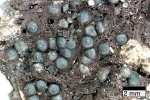
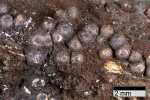
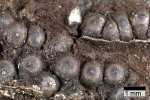
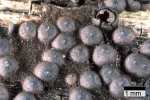
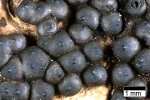
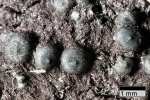
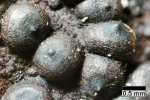
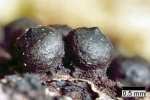
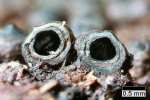
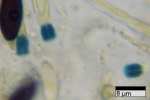



|
Rosellinia aquila (Fr.: Fr.) De Not.
Stromata scattered to densely gregarious, uniperitheciate,
at times fused in a few peritheciate stroma, brown to black, subglobose often constricted
at the base, apex flattened to slightly conical, 0.9-1.2 mm high x 0.9-1.3 mm diam;
ectostroma hard, carbonaceous; subiculum brown to purplish brown, abundant,
woolly, persistent at least at the base of mature stromata, long adhering to
side walls, usually conspicuous
between the stromata.
Ostioles papillate, conical.
Asci cylindrical, with apical apparatus more or less urn-shaped, amyloid,
4.8-6.8 µm high x 4-5.5 µm broad.
Ascospores (15-) 18-22 x 6-8 µm, ellipsoid-inequilateral with broadly
to narrowly rounded ends, dark brown, with a straight germ slit spore-length on the
more convex side; both ends with a cellular appendage up to 2 x 1.5-1.8 µm surrounded
by a slimy cap.
Anamorph in nature: Geniculosporium-like, grey to light brown,
present on subiculum at young stages.
Specimens examined: FRANCE: Ariège (09): Allières, Thézaut,
12 Apr. 1996, JF-96037, on Fraxinus excelsior; Le Mas d'Azil,
Portetény, chemin de croix, 22 Mar. 2003, JF-03046, on Hedera helix.
Charente Maritime(17):
Ile de Ré, Saint Martin en Ré, les Sallières, 28 Apr. 2004, JF-04048, leg. Paul
Leroy, on Quercus ilex; Haute Garonne (31):
Fonsegrive, 24 Janv. 1999, JFM-9904, on broad leaved tree;
Escalquens, JFM's place of residence, 9 June 2002, JFM-0228, on Ficus.
Indre et Loire (37): Joué lès Tours, 09 Mar. 1996, PL-960309-05,
leg. Paul Leroy, on Tilia. Deux Sèvres (79): Poivendre
de Marigny, Jan. 2004, JF-04023, leg. Christian Lechat, on Robinia pseudoacacia.
Vendée (85):
Monts, Forêt de la Barre de Monts, 17 Oct. 1985, PL-851017-01, leg. Paul Leroy,
on unidentified wood.
Notes: Rosellinia aquila is the type species of the genus Rosellinia,
representative of the subgenus Rosellinia erected by Petrini (1993) for
species with large and hard textured stromata embedded in a persistent subiculum. It
cannot be distinguished macroscopically from R. corticium, their separation
is based on microscopical differences in ascospore morphology and dimensions,
and dimensions of ascal apical apparatus.
Typical material of R. aquila differs from typical material
of R. corticium in smaller ascospores averaging 20 x 7.5 µm (vs. 24 x
9 µm in R. corticium) with a cellular appendage at both ends, surrounded
by a slimy cap, while ascospores of R. corticium have one cellular appendage
and are wholly surrounded by a slimy sheath. In R. aquila, ascal apical
apparatus averages 5.5 x 4 µm, vs. 8 x 5.5 in R. corticium (Petrini,1993).
In addition, significant differences in conidial size are reported from anamorph
in nature and anamorph obtained in culture (Petrini,1993). In
one collection examined (JF-04048), ascospores are typical for R. aquila
as to morphology and dimensions, but ascal apical apparati are much larger (7-10
x 4.8-5.5 µm) than usually accepted for this species. Other deviating collections,
with intermediate characters between R. aquila and R. corticium,
are discussed under R. corticium.
Petrini (1993) reports R. glabra (Fuckel) Petrini as a distinct species,
known from one collection on Ruscus aculeatus in Italy. It is said to
differ from R. aquila through smaller stromata and smaller ascospores.
Two collections, JFM-9904 and JF-96037, have ascospores respectively 15-18.5
and 16-19 µm long and therefore could be related to R. glabra.
Rosellinia aquila is known from Europe, Japan and North
America ( (Petrini,1993). Its distribution in France seems to be under
atlantic influence, as its appears to be much rarer in southern France than
R. corticium. In contrast, it is said to be more frequent in western
France (C. Lechat, pers. comm.), which corroborates Petrini's observations (1993)
that R. aquila is frequent in Great Britain while R. corticium
has not yet been recorded form this country. As to their relative distribution,
R. aquila and R. corticium have been so frequently confused
that further studies on material from other parts of Europe are needed.
|